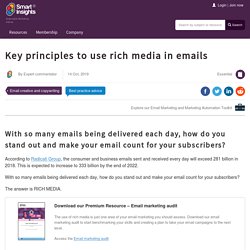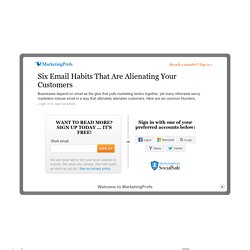

Email marketing trends 2021 - 5 trends to watch. In 2020, email marketing has, like so many parts of our work and personal lives, had to undergo a rapid transformation.

As the pandemic continues to lead to wide-ranging changes to the way consumers perceive brands and consider purchases, email marketers have adapted in many innovative and inspiring ways. In this blog, five of the brightest minds from the world of email marketing provide their key trends for 2021. With email continuing to play a vital role in nurturing, acquiring and retaining customers, it’s time to explore the opportunities that lie ahead. Email marketing through the K-shaped COVID-19 recovery As we head into 2021, COVID-19 continues to impact marketing strategies and budgets within organizations of all sizes and industries. Its impact on different nations and demographics has been hugely varied. McKinsey analysis shows just how that is expected to play out for different sectors, with the recovery potentially taking more than five years for the hardest hit.
Chad S. Email marketing trends 2021 - 5 trends to watch. La newsletter se réincarne. Email marketing trends 2021 - 5 trends to watch. Email Marketing Strategy: The Best Way to Organize Yours (Template) Managing email marketing successfully isn’t easy, especially when you have multiple email initiatives going at once.

The value of email marketing is undeniable, so it’s not surprising that many departments within your organization want to leverage the platform. This results in lots of moving pieces to consider and many stakeholders to please. It also increases the chances of accidentally sending multiple emails to the same person in one day. Speaking from personal experience… the fallout of this isn’t pretty. Here are just a few pieces of the puzzle you have to consider: Managing your ever-growing subscriber listOverseeing the design and copy of every emailScheduling delivery timesA/B testingAnalyzing results That’s just scratching the surface.
Integrating Direct Mail and Digital Marketing for Campaign Results. How are marketers supposed to cut through the digital marketing clutter when email response rates hover around 1%?

All it might take is an offline nudge with the help of direct mail, according to offline automation platform Postal.io. B2B marketing and sales outreach now entails email, LinkedIn, Twitter, text, phone conversations… The result is overload, digital or otherwise, but the integration of offline into the mix can help cut through the noise. That's similar to the point made in a companion infographic we've published: "B2B Direct Mail for Marketing and Sales. " It's also the argument in favor of integrating digital and offline direct that the following infographic by Postal.io lays out.
Check it out: Key principles to use rich media in emails. According to Radicati Group, the consumer and business emails sent and received every day will exceed 281 billion in 2018.

This is expected to increase to 333 billion by the end of 2022. With so many emails being delivered each day, how do you stand out and make your email count for your subscribers? The answer is RICH MEDIA. Download our Premium Resource – Email marketing audit The use of rich media is just one area of your email marketing you should assess. Access the Email marketing audit What is rich media? Six Email Habits That Are Alienating Your Customers. Businesses depend on email as the glue that pulls marketing tactics together, yet many otherwise-savvy marketers misuse email in a way that ultimately alienates customers.

Here are six common blunders. 1. Slack va-t-il (enfin) remplacer l'e-mail en entreprise ? Les cadres français passent en moyenne 5,6 heures par jour sur leurs e-mails, selon une étude d'Adobe.

Lire, répondre et trier les messages électroniques s'est transformé en cauchemar, en "esclavage". Un problème entendu par tous les géants de la high-tech, de Google à Yahoo, qui entendent "révolutionner" le courriel avec des solutions de tri automatique. Mais elles s'avèrent, pour l'heure, très insuffisantes... Finalement, la solution viendrait non pas d'une révolution mais d'une substitution.
Exit l'e-mail, place à Slack. Cette plateforme gratuite se situe à l'intersection du réseau social d'entreprise et de l'espace de discussion instantanée. L'ensemble paraît classique, mais se révèle soutenu par une interface d'une incroyable simplicité, permettant une productivité maximisée. "Nous utilisons Slack pour échanger toutes sortes d'informations internes", raconte à "l'Obs" Edouard Morhange, cofondateur de la start-up Storyplayr, bibliothèque numérique de livres pour enfants. 10 benefits of email marketing - Pure360. Sales - Tradeshow Hero: How to Use Email and Marketing Automation for Live-Event Success. Companies benefit in many ways from exhibiting at tradeshow, including by securing face time with busy executives—a coveted advantage in today's marketplace.

Asked to rank the most effective ways to brand and generate demand, nearly 50% of respondents to a 2014 Chief Marketing Officer Council study cited events and tradeshows. Other channels have their advantages, but they are no substitute for direct contact. Being physically present gives B2B innovators an opportunity to build and solidify relationships with clients and prospects. It also offers them the chance to compare how well they stack up against other players on the showroom floor. Why Newsletters Are Having Their Moment - And Perhaps Many More To Come. For most, the term “newsletter” likely does not go hand-in-hand with the world of high-tech communication.

It’s a periodical for elementary schools and religious organizations, making clear details for PTA meetings and community bake sales, either haphazardly pasted into an email or meticulously crafted on some version of Microsoft Publisher with built-in clip-art and color schemes. So, how is it, then, that the utilitarian and decidedly un-trendy newsletter became the medium of choice for some of the most popular and talked-about online publications for Millennials, and, as a concept in general, gained a surprising amount of steam as of late?
There are two major factors that make the concept of an email newsletter compelling against the frenzied backdrop of online media in 2015 – the milieu of bloggers and micro-bloggers and Reddit threads and comments-section fights and everything else that one must digest to be culturally literate during the Internet age. The first element is delivery. Three Excellent Reasons for Adding Dynamic Content to Your Next Email. In the noisy, crowded jungle of modern marketing, dynamic content is the ultra-adaptive chameleon: It changes itself based on demographics or preferences of your subscribers.

Dynamic content can be tricky to spot, because when done right, the recipient just thinks your brand is really good at personalizing content. Moreover, because 56% of people unsubscribe from emails due to content that's no longer relevant, personalized content is a modern marketer's most time-saving and effective tool for keeping subscribers engaged. Dynamic content takes personalization to a whole new level, allowing marketers to target individual subscribers with different content—all from a single email. Dynamic content is also incredibly diverse: Uses include inserting your subscribers' name into subject lines and switching out images and full copy according to purchase history or interests.
The more personalized the content, the more effective the message. 1. See how that saves a ton of time? 2. 3. 2015 Email Benchmarks by Industry. How do email campaigns' open rates, click-through rates, click-to-open rates, and unsubscribe rates vary by industry?

To find out, Silverpop examined data from messages sent by nearly 750 companies representing 3,000 brands in 40 countries. A broad set of message types sent by companies in a variety of verticals were included in the study, including promotional emails, content-based newsletters, automated emails, and transactional messages. Below, key findings from the analysis. To see definitions of the metrics, as well as how performance varies by region, check out the full report. Unique Open Rates Five verticals have especially high mean unique open rates: hospitality and travel; insurance; consumer products; nonprofits and government; and education. The retail/e-commerce and media/publishing verticals have the lowest mean unique open rates.